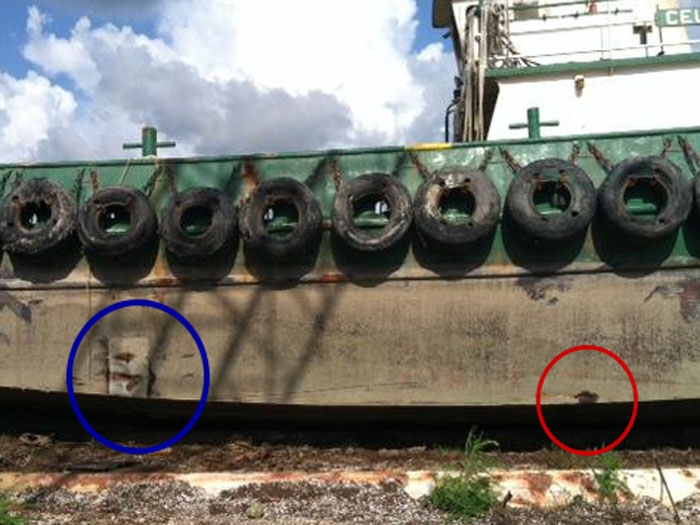
NTSB reports on OSV allision and sinking
Written by Nick Blenkey
Damage to starboard side of the Celeste Ann. The first impact punctured the hull along the vessel's chine in the area of the pump room (circled in red at right). The second impact caused two punctures to the hull near the engine room (shown circled in blue at left)
JANUARY 21, 2015 — The National Transportation Safety Board has issued a Marine Accident Brief on the June 14, 2013 allision and sinking of the offshore supply vessel Celeste Ann in the Gulf of Mexico, 20 nautical miles southeast of Grand Isle, LA.
Celeste Ann was receiving passengers from West Delta oil platform 73 about 20 nautical miles southeast of Grand Isle when the vessel allided with the platform about 08:36 AM. The allision punctured the hull, and the Celeste Ann subsequently flooded and sank. All passengers and crew evacuated to another vessel, and no one was injured.
The vessels crew consisted of two credentialed masters, one senior and one junior, and two deckhands. The junior master and a deckhand stood a 12-hour watch from midnight to noon.
From 06:00 to 08:00, the Celeste Ann made several runs between West Delta 73 platforms A, B, and C to transport passengers and other materials.
About 08:10, the vessel arrived at West Delta 73 platform A to pick up passengers. The junior master backed the vessel into the landing area and held position for the transfer.
The vessel was positioned stern in to the platform with its bow into a northwest wind of about 15 knots in 2- to 4-foot seas. Between 08:20 and 08:30, eight passengers boarded using the crane and man-lift on the platform. Shortly after taking on the passengers, the bow began to swing to starboard and the wind pushed the vessel sideways towards the platform.
The junior master attempted to maneuver the vessel away from the platform, but he was unable to overcome the wind on the vessel’s beam. Celeste Ann allided with the platform.The junior master sent the deckhand to the engine room to check for damage, and the deckhand found flooding from a 2-foot gash on the starboard side. The junior master sounded the general alarm and went to the engine room to assess the damage, passing through a watertight door on the portside main deck, down a ladder into the pump room, and through a second watertight door to reach the engine room, which was aft of the pump room.
The junior master told Coast Guard investigators he saw water in the bilges approaching the deck plates. He turned on both dedicated bilge pumps and a fire pump capable of bilge suction, but he did not close any of the watertight doors before returning to the bridge. The Coast Guard determined that even if the pumps had been operating properly, the likely rate of flooding would have exceeded their capacity.
About 09:00, another offshore supply vessel, the Oddysea Endeavor, pulled alongside the Celeste Ann to assist. By 09:10, the Celeste Ann lost electrical power and, as a result, lost steering capability, and all passengers and crew evacuated to the Oddysea Endeavor by 0915.
With watertight doors left open, progressive flooding ensued, and the Celeste Ann sank about 10:00..
About a month later, the owners of the Celeste Ann decided to salvage the vessel, and it was raised and brought to Morgan City, LA, for repairs. A damage survey determined that the initial impact with the landing platform resulted in a 2-inch-wide hole about 7 feet below the waterline near the pump room. The second impact resulted in two holes in the engine room␣one about 1 inch in diameter located 6 feet below the waterline and another about 12 inches by 1 inch about a foot below the first.
The Coast Guard estimated the total flooding rate to be greater than 1,000 gallons per minute. Estimated costs to salvage and repair the vessel were $1 million.
The platform owner conducted an underwater survey of the landing area on the West Delta 73A platform after the accident. The survey noted that a vertical pipe on the platform was arranged with a clamp attaching the vessel landing to the platform. The clamp had two horizontal protrusions that extended off the vertical pipe that likely punctured the hull of the Celeste Ann.
Probable Cause
The National Transportation Safety Board determines that the probable cause of the allision of the offshore supply vessel Celeste Ann with West Delta 73 platform A was the inability of the junior master to compensate for and overcome wind forces that pushed the vessel into the platform. Contributing to the hull breach and subsequent sinking of the Celeste Ann were underwater protrusions from the platform and open watertight doors on board the vessel.
Download the Marine Accident Briefing HERE





Leave a Reply
You must be logged in to post a comment.